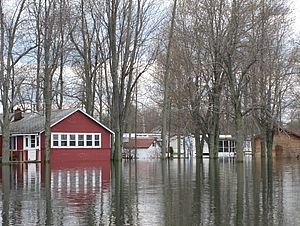Lake and River Protections

Lake flooding in 2011. Photo by Chuck Woessner.
The Vermont legislature ended up merging and then passing lake and river bills that had been considered during the session. The larger bill institutes a suite of programs that will help Vermont prepare for and cope with future flooding issues. The final bill established a study committee to identify new funding sources for water quality protection and restoration efforts. The study committee will consider assessing a small fee on all impervious surfaces in the state similar a stormwater utility. LCC has long supported such programs under the principal that more impervious surfaces leads to more stormwater pollution.
The bill shifted authority for issuing many state rules from the Water Resources Panel to the Agency of Natural Resources. The Panel is a public body, independent of the Agency of Natural Resources, comprised of four citizen members plus a Chair; the Agency consists of a large staff of environmental professionals led by a Governor-appointed Secretary.
The bill clarified management obligations in emergency situations. Following Tropical Storm Irene there was a great deal of confusion about what work was and was not allowed in-streams. As a result, numerous poorly considered berming and dredging projects took place that could lead to long-term instability in river systems. The bill requires the Agency of Natural Resources to establish a general permit that will come into affect when a State of Emergency is declared. The permit outlines the types of acceptable and unacceptable in-stream work that might occur. The bill also calls on the Agency of Natural Resources to map suspected Flood Hazard Areas, locations where we might anticipate changes in a river’s course during severe storms.
